Physics 15 Torque Fundamentals (8 of 13) How to Calculate a Torque (Basic Example 2)
TLDRThe video script presents a classic physics problem involving the calculation of torque. It features a beam, 2 meters in length, inclined at a 60-degree angle to the horizontal, with a 10-kilogram mass hanging from it via a cable. The force exerted by the mass, equivalent to its weight (mass times gravitational acceleration, G), acts along the line of the beam. The torque is determined by multiplying this force by the perpendicular distance from the line of action of the force to the pivot point, which in this case is the length of the beam times the cosine of the angle. The resulting torque is calculated to be 98 Newton meters, with a clockwise direction, denoted as negative in vector notation. The problem is solved using trigonometric principles and provides a clear understanding of how torque is calculated and its directional implications.
Takeaways
- 📐 The problem involves calculating the torque caused by a mass hanging from a cable attached to a beam.
- 📏 The beam is 2 meters long and makes a 60-degree angle with the horizontal.
- 📚 The mass of the object is 10 kilograms, and the force acting on the beam is equal to the weight of the object (mass times gravity).
- 🔵 The force's line of action can be extended to find the perpendicular distance from the force to the pivot point, which is key for torque calculation.
- 📐 Torque is calculated as the force times the perpendicular distance from the force's line of action to the pivot point.
- 📉 The adjacent side to the 60-degree angle in the triangle formed by the beam, the force, and the ground represents this perpendicular distance.
- 📌 The formula for torque in this context is the weight of the object (mass times gravity) times the length of the beam times the cosine of the angle.
- 🔢 Plugging in the values, the torque is calculated as 10 kg × 9.8 m/s² × 2 m × cos(60°), which equals 98 Newton meters.
- ➡️ The direction of the torque is clockwise, which is considered negative in this context.
- ⚙️ The magnitude of the torque is 98 Newton meters, and when considering direction, it is represented as a vector pointing into the negative Z direction.
- 📝 Torque can be expressed both as a scalar (magnitude only) or as a vector quantity (magnitude and direction).
Q & A
What is the mass of the object hanging from the cable?
-The mass of the object is 10 kilograms.
What is the length of the beam?
-The length of the beam is 2 meters.
What is the angle the beam makes with the horizontal?
-The beam makes an angle of 60 degrees with the horizontal.
What is the force acting on the beam due to the hanging object?
-The force acting on the beam is the weight of the object, which is the mass times the acceleration due to gravity (10 kg * 9.8 m/s^2).
What is the formula for torque in this context?
-The torque is equal to the force (weight of the object) times the perpendicular distance from the line of action of the force to the pivot point.
How is the perpendicular distance calculated in this scenario?
-The perpendicular distance is calculated as the length of the beam (L) times the cosine of the angle (cosine of 60 degrees).
What is the value of the torque calculated in the script?
-The torque is calculated to be 98 Newton meters.
In which direction would the beam rotate if it was subjected to the force alone?
-The beam would rotate in a clockwise direction.
What is the term used to describe a clockwise torque?
-A clockwise torque is also known as a negative torque.
How can the direction of the torque be represented in vector notation?
-The direction of the torque can be represented as a vector quantity with a negative sign indicating the direction into the board, which is the negative Z direction.
What is the acceleration due to gravity (G) used in the calculation?
-The acceleration due to gravity (G) used in the calculation is 9.8 m/s^2.
What is the significance of considering the force's line of action in calculating torque?
-Considering the force's line of action is significant because it helps determine the perpendicular distance from the force to the pivot point, which is essential for calculating the torque.
Outlines
🔍 Calculating Torque on a Hanging Mass
The video introduces a classic physics problem involving a beam with a hanging object, aiming to calculate the torque exerted by the object's weight. The object has a mass of 10 kilograms, and the beam is 2 meters long, making a 60-degree angle with the horizontal. The weight of the object is used as the force, and a right triangle is formed to determine the perpendicular distance from the force's line of action to the pivot point. The torque formula is presented as the force (weight of the object) times the perpendicular distance (L times cosine of the angle). After substituting the given values, the torque is calculated to be 98 Newton meters. The direction of the torque is determined to be clockwise, which is considered negative in vector notation, and is represented as -98 Newton meters towards the negative Z direction.
Mindmap
Keywords
💡Torque
💡Beam
💡Mass
💡Weight
💡Angle
💡Pivot Point
💡Force
💡Perpendicular Distance
💡Cosine
💡Newton
💡Direction of Torque
💡Vector Quantity
Highlights
The example involves calculating the torque caused by a mass hanging from a cable attached to a beam.
The mass of the object is 10 kilograms.
The length of the beam is 2 meters.
The beam makes an angle of 60 degrees with the horizontal.
The force acting on the beam is equal to the weight of the object times gravitational acceleration (G).
A triangle is formed, allowing for the use of trigonometry to find the torque.
The line of action of the force can be extended to find the perpendicular distance to the pivot point.
The torque is calculated as the force times the perpendicular distance from the line of action of the force to the pivot point.
The hypotenuse of the triangle is the length of the beam (L), and the adjacent side is the perpendicular distance (D).
The torque formula is derived as the weight of the object times G, times the length of the beam, times the cosine of the angle.
The numerical values used in the calculation are mass (10 kg), gravitational acceleration (9.8 m/s^2), and length of the beam (2 m).
The cosine of 60 degrees is used in the calculation, which equals 1/2.
The calculated torque is 98 Newton meters.
The direction of the torque is clockwise, also known as a negative torque.
Clockwise torque implies a rotation in the clockwise direction.
The torque can be represented in vector notation as a negative 98 Newton meters in the Z direction.
The magnitude and direction of the torque are both important for a complete understanding of the effect on the beam.
Transcripts
Browse More Related Video
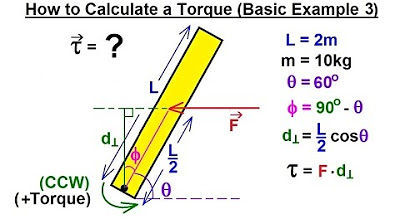
Physics 15 Torque Fundamentals (9 of 13) How to Calculate a Torque (Basic Example 3)
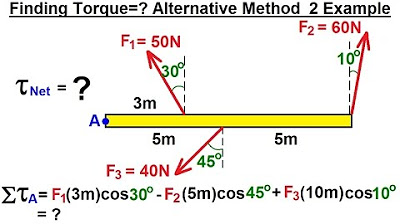
Physics 15 Torque (9 of 27) Alternative Method 1 & 2: Example Torque=?
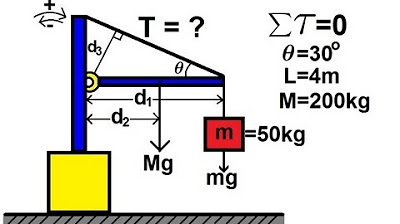
Physics 15 Torque Example 1 (1 of 7) Mass on Rod and Cable

Physics 15 Torque (3 of 27) Tension=? in the Cable
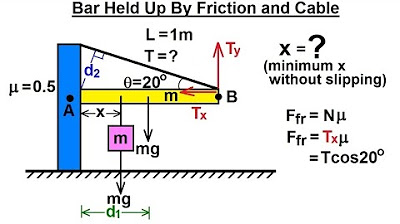
Physics 15 Torque (4 of 27) Bar Held Up by Friction
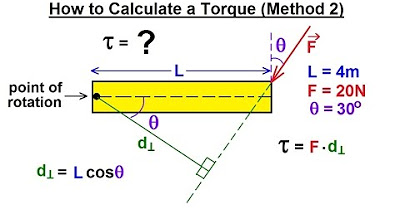
Physics 15 Torque Fundamentals (5 of 13) How to Calculate a Torque (Method 2)
5.0 / 5 (0 votes)
Thanks for rating: